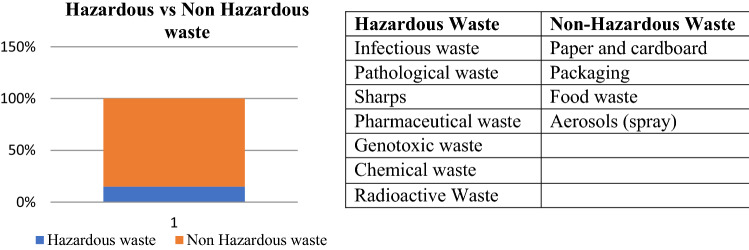Abstract
The change in habits and lifestyle of citizens during health crisis like COVID-19 pandemic has resulted in an unprecedented increase in the struggles for solid waste management across the globe. Not only underdeveloped and developing economies are struggling with the challenges posed by mounting piles of infectious waste but even developed countries are adversely affected in similar manner. The routine waste management strategies followed by various countries are overturned due extremely altered trends in the amount and type of waste generated by households and medical facilities. The aim of this paper is to study and list the best available waste management policies adopted by some developing, developed and underdeveloped economies. The listed case studies were selected due to some unique steps undertaken for solid waste disposal during pandemic. The findings revealed that the guidelines issued by WHO for waste management of corona virus infected waste were followed by these nations and certain additional preventive steps were taken. Due to unavailability of single framework as prescribed by international authorities, various sustainable steps taken by individual countries to curb the pandemic menace can be useful in the present context. Few of these measures can be permanently adopted at global level by other nations for handling the pandemic like situations efficiently in pandemic situations.
Keywords: Waste management, COVID-19, Waste, Environment
Introduction
Efficient and sustainable management of solid waste accounts for general well-being and healthy lifestyle of residents for any nation. Proper planning and effective execution of waste collection and disposal remains the prime concern of local authorities to maintain hygienic surroundings. Its importance has seen a many fold increase in the today’s prevalent COVID like pandemic scenario. In contrast to witnessing a much cleaner and healthy environment like cleaner air due to reduced pollution level, this global pandemic has caused a sudden sharp increase in the quantity of solid waste generated leading to serious health threats for people involved in sanitation duties (Acharya et al. 2021). As the waste increases there is a serious problem for hospitals and medical institutions in the nations where medical waste coincides with municipal waste that threatens the health of the frontline staff, general public and the environment as a whole. This mixing of additional virus infected clinical and healthcare waste with conventional municipal waste threatens the service continuity of sanitation workers due to increased risk of contamination. The release of large quantities of PPE kits, used masks, gloves and other personal protection gears is posing a greater challenge to the authorities as they may contribute to resurgence of the virus spread if not disposed with proper process and treatment (Sharma et al. 2020; Kulkarni and Anantharama 2020).
The ability of SARS-CoV-2 particles to survive for longer durations on various materials makes it even more contagious and liable for large scale transmissions (Ronca et al. 2021). This not only holds true for current pandemic situation but also teaches us a lesson to think and analyse the scenarios which may arise in future due to other pathogen promoting pandemics like floods, earthquakes and other infectious diseases (Khanna et al. 2020). The already derailed solid waste management strategies during this pandemic has affected, and will further deteriorate the regular operations of waste management systems worldwide. Since the personal care regimes of every individual has changed drastically, enormous amount of single-use plastic waste and packaging waste is overloading the already burdened waste management plants thereby posing a serious threat to our environment (Leal Filho et al. 2021; Haque et al. 2021; Oliveira et al. 2021).
The rules set-up by World Health Organization (WHO) suggests various ways for handling and processing the sudden elevated volume of biomedical wastes along with medical waste generated from general households and temporary medical centers where quarantined patients are being monitored or treated (WHO 2015, 2017; World Health Organization 2020). But still it is evident that no existing concrete steps have been taken by different countries for disinfecting and disposing the used medical waste and equipment generated from medical institutions and households as well. This has proved to be a setback for the global efforts toward sustainable management of waste products for cleaner and greener planet.
This paper reviews the global scenario of solid waste generation and management associated with the household, quarantine centers, hospitals, infected patients, etc. due to the COVID-19 pandemic. Moreover, the review also discusses how waste can be handled or recycled to reduce disease spread through solid waste. It also provides insight into the steps taken by various nations to manage solid waste during the COVID-19 pandemic.
Materials and methods
Structured analysis
The first relevant step in writing an analytical study is selection of relevant papers and articles. Various techniques and methodologies like literature study, historical and bibliometric analysis have been used by the researchers to extract the topic of research. Researchers have been using literature review approach for building their research and relating it to existing known findings (Cooper et al. 2018; Hartling et al. 2016; Tranfield et al. 2003; Eisenhardt and Graebner 2007). To identify the exact problems and emerging issues literature study provides a focused and accessible method in synthesis of results. Here in this work, we have followed systematic literature review method for selection of articles.
To achieve a structured review analysis, we searched multiple databases followed for research purpose including Google Scholar, Scopus and WebofScience. We searched for keywords like ‘Solid waste management’, ‘pandemic’, ‘COVID-19’, ‘SARS-CoV-2’, ‘healthcare waste’, ‘solid waste management in developing countries’, ‘solid waste management in developed countries’, ‘solid waste management in underdeveloped countries’, solid waste management in Asian economies’, etc. To collect the actual data related to daily waste generation by different countries website www.worldometers.info was used. Information related to solid waste management was available for various nations, but only those countries where maximum data on solid waste management along with medical waste disposal was available.
Quantitative impact of COVID-19 on solid waste generation
The present pandemic has altered the amount of solid waste being generated from not only healthcare facilities but household waste as well. The healthcare waste comprises all the hazardous and non-hazardous waste generated from medical centers, laboratories and medical waste from self-quarantined patient’s household (UNEP-IETC 2012). Figure 1 gives a brief classification of types of hazardous and non-hazardous medical waste.
Fig. 1.
Hazardous and non-hazardous medical waste
Unexpected lockdowns and work from home scenario has resulted in an unprecedented increase in household waste due to increase in consumption rate and cook at home culture in various developed countries also. Additionally, non-availability of waste collection workers and reduced collection frequency resulted in overburdening of disposal plants forcing them for improper disposal (Haque et al. 2021; Tchetchik et al. 2021; Hantoko et al. 2021). Extreme changes in consumer demands during pandemic outbreak has alleviated difficulties in tackling with single-use plastic waste. Much safer plastic packaging for food and other essential items for daily needs has caused a reversal of consumer attitude from plastic worrying to plastic preferring leading to major setback of environment concerns in current pandemic scenario (Prata et al. 2020; Selvaranjan et al. 2021).
Additional medical and household waste burden due to PPE
As per pre-COVID quantitative analysis, only 10–25% of medical waste amounts to hazardous waste. But in current scenario 100% waste is medical waste, categorized as hazardous with an increased risk of infection spread. This demands for additional care and precautions for their collection, treatment and disposal which was normally not required. As per the new recommendation of WHO (World Health Organization) it is desired to wear proper PPE (Personal Protection Equipment), such as face mask, high quality gloves, full sleeves medical gown, shoe cover, face shield etc., should be used by healthcare workers for treatment and care of COVID-19 infected patients. These protection gears should be one time use and disposed properly after use and their reuse should be avoided. Additionally, enormous amount of single use sample collection containers, syringes and packaging material used in testing kits are contributing to PPE induced environmental pollution every single day. Tables 1, 2 below shows the increase in medical waste during COVID-19 in some cities and increase in hazardous waste generated (https://www.eco-business.com/news/adb-coronavirus-could-leave-major-southeast-asian-cities-with-1000-extra-tonnes-of-medical-waste-per-day/).
Table 1.
Increase in medical waste due to COVID-19
| City | Population (in million) | Healthcare waste (tones per day) | Additional healthcare waste generated during COVID-19 (tones per day) | % Increase |
|---|---|---|---|---|
| Manila | 14 | 47 | 280 | 496 |
| Jakarata | 10.6 | 35 | 212 | 506 |
| Bangkok | 10.5 | 35 | 210 | 500 |
| Ha Noi | 8 | 27 | 160 | 493 |
| Kuala Lumpur | 7.7 | 26 | 154 | 492 |
Table 2.
Estimated hazardous waste generated by some countries
| Country Name | Ani | Generated daily hazardous waste amount (t/day) | Total Production in 100 days (t) |
|---|---|---|---|
| South Africa | 137,977 | 469.12 | 46,912.18 |
| United States of America | 2,369,126 | 8055.03 | 805,502.84 |
| Brazil | 815,986 | 2774.35 | 277,435.24 |
| Mexico | 105,515 | 358.75 | 35,875.10 |
| Iran | 23,914 | 81.30 | 8130.76 |
| Egypt | 37,805 | 128.54 | 12,853.70 |
| Italy | 13,263 | 45.09 | 4509.42 |
| India | 635,393 | 2160.34 | 216,033.62 |
| Bangladesh | 105,831 | 359.83 | 35,982.54 |
| Argentina | 133,651 | 454.41 | 45,441.34 |
| Colombia | 161,951 | 550.63 | 55,063.34 |
Issues in solid waste management during the COVID-19 pandemic
Collecting and managing the solid waste is an essential service whose actual worth became apparent during these testing times of COVID-19 disease. This pandemic has highlighted the lack of vision and preparedness of our existing waste management strategies and policies. The already increasing waste generation in some of the populous cities is posing a serious environment pollution threat and this onset of COVID-19 has further deepened the crisis. The alleviated health risks due to contaminated medical waste is challenging the waste management sectors of not only developing countries but also the developed countries. Lack of awareness among the general people for possible solutions and methods of handling and disposing this waste, played an equally important role in this mismanagement (Singh et al. 2022). Following are some issues responsible for mismanagement of solid waste during pandemic:
The lack of training and proper resources for environmental issues in low-income developing countries led to unmanageable solid waste management.
The perception of residents that only government authorities are responsible for handling the municipality waste led to the improper disposal of infectious household waste even on the streets.
Inefficient waste dumping practices of open landfills in underdeveloped countries and even some developing countries exposed the infectious waste to rag pickers who often collected PPEs for resale.
The possible local solutions for the above-mentioned problems needs to be identified and effective implementation of a strategic plan of action should be ensured for proper waste management of waste generated from households and healthcare institutions with infected people and people suspected of infection as well. The following few points will help us to understand the current waste management models of nations and possible planning for such pandemic in future.
Separation of waste at source end itself can be identified as a crucial step toward sustainable handling the solid waste.
Further inclusion of 3R (reduce, recycle and reuse) with source separation should be perceived as an essential way for sustainable management and reduced contamination rate.
General public awareness and their participation in government schemes and drives is inevitable for any nation in this age of ever-increasing population. This increase in population is responsible for sharp increase in waste generation rates (Behera 2021).
For ensuring financial stability in continuous waste collection logistic services and maintaining abundant staff, it is a good idea to analyse the feasibility of implementing cost sharing policy with the consumers (Diggle and Walker 2020). This concept is already implemented in some of the countries where consumers have to pay some charges for the amount of waste they dispose (Dunne et al. 2008; Chu et al. 2019; Reschovsky and Stone 1994). This encourages less waste generation in households and can be seen as an economic incentive for the residents.
It should be ensured that all the movable and immovable equipment involved in municipality waste collection process are disinfected properly on daily basis.
To lower the infection risk for residents, open landfills and easy accessibility to these landfills must be discouraged by the concerned authorities.
The implementation feasibility of traditional decontamination and waste disposal methods must be scrutinized very wisely, preferably region wise, before their implementation. Regions which lack decontamination facilities can look upon less preferred schemes like incineration, for short time decontamination of infectious waste.
It is very important to provide financial and social safety to the sanitation workers to ensure their uninterrupted services for the nation. They should be free from the worries of future provisions of their families.
Government agencies and research fraternity needs to look for innovative ideas to covert or reuse this waste for the purpose of energy generation.
Latest technologies and methods like machine learning, artificial intelligence and internet of things can be combined with conventional waste management strategies for revamping the system (Manojkumar et al. 2021; Batra et al. 2019; Mann et al. 2020; Hooda and Mann 2020; Kherwa and Bansal 2021).
Processing technologies in use for waste management
Following the guidelines set by various agencies, there are different technologies, as listed below, which are already in place for processing the solid waste efficiently. Special focus is desired on awareness of adopting additional strategies required in today’s pandemic situation since many countries still continue to apply the traditional waste collection methods.
-
Incineration process
Incineration is an oxidation process carried out at high temperature to convert combustible organic process into incombustible inorganic material which helps in significant reduction in the volume of generated municipal waste (Rigamonti et al. 2020). High temperatures around 1000 °C ensures proper decontamination which requires no further treatment. Although it helps in reducing the pollution due to municipal solid waste at the cost of elevated amounts of gaseous emission. Highly toxic carbon dioxide and nitrogen oxide-based residual gases poses a serious health concern for human beings.
-
Pyrolysis procedure at high temperature for disinfection
In pyrolysis, the organic waste material is thermochemically decomposed in inert conditions without oxygen. Even the plastic waste and tire breaks can be converted into pyrolysis oil which can be use as generator fuel in industries (Banerjee et al. 2019). Pyrolysis is getting attention as the temperature requirement for this combustion process is less as compared to incineration with much lesser polluting gas emissions. Very less amount of energy is required for its continuous operation as it is self-sustainable. It demands no external fuel supply for operation lowering the operational cost of the whole process. In spite of all these advantages, highly monitored and sophisticated operation techniques involved in pyrolysis makes it less favorable for mainstream usage.
-
Using low temperature microwave for disinfection
There are evidences available to prove the ability of specially designed microwave systems for inactivating the microorganisms (Zimmermann 2017). A safe closed unit can be used for treating various personal and clinical kits waste preventing the release of gases liberated during disinfection procedures. Option of direct disposal of the disinfected waste on open landfills makes it a much favorable option as the residue generated is non-hazardous. Although quantity of waste is not highly reduced but process itself is very simple and flexible.
-
Using chemicals for disinfection
Chemical treatment of solid waste disposal aims at changing the basic molecular structure of the matter (Vanapalli et al. 2021). It is a disinfection method where pathogens are rendered inactive as compared to sterilization process which aims at eliminating the pathogens completely. Because of chemicals it carries disadvantages like requirement of trained personnel due to hazardous nature of the chemicals involved. Only the surface molecules which comes in direct contact are disinfected and material dumped beneath a huge heap may remain non-treated.
Case studies of waste management
Covid-19 pandemic situation highlighted the demand of special and efficient waste management strategies which have already been laid by few nations. Novel and non-conventional solutions are being sought by the nations in these different situations to guide them and help them tackle with enormous amount of hazardous waste generated worldwide. The current waste management strategies are governed and executed by individual nations independently which resulted in their ineffective and improper implementation. These inefficiencies and faulty structure of these policies needs to be revised and monitored for overall sustainable existence of the present and future population. WHO (World Health Organization) has laid out certain rules and policies to be implemented while disposing-off the healthcare waste generated from medical facilities and households. Following case studies highlights the waste management strategies adopted by some of the developing and developed economies around the world during Covid-19 pandemic.
Covid-19 waste management in INDIA: a developing economy
In 28 states of India, there are about 200 biomedical waste treatment facilities treating waste of health care facilities. Depending on the type of waste different methods are used for the disposal. Soiled waste like infected cotton swabs, bandages etc are treated using incineration. Fiber-based PPE kits are incinerated while the blood and fluids infected bedding and sheets are first treated with non-chlorinated chemicals before incineration. Vaccines and other specimens are either autoclaved or treated with chemicals before sending to landfills. Recyclable items like gloves, urine bags, IV tubes etc. are autoclaved, shredded and then sent for recycling. Additional guidelines and measures were issued by Central Pollution Control Board for handling Covid-19 waste. Separate trolleys and vehicles are used for transporting the infected waste from healthcare facilities. Disinfection of these equipment is done using sodium hypochlorite solution for containing the spread of virus from contaminated residue. Infected waste is separately labelled as Covid-19 waste to ensure extra cautious collection and handling by sanitation worker.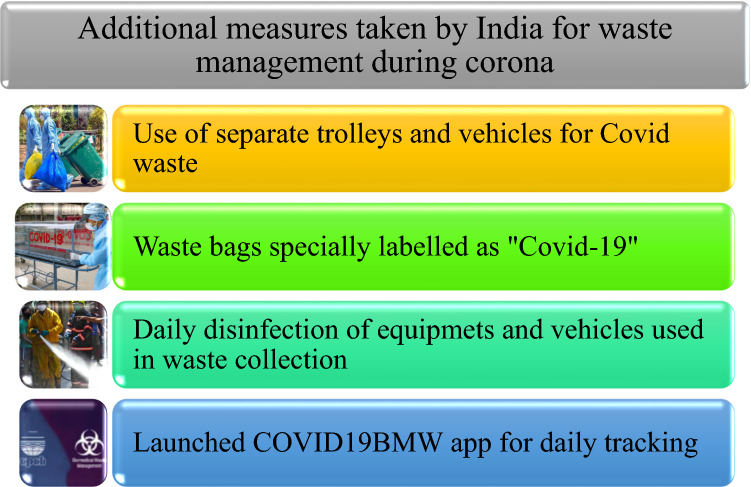
For general public, yellow bags were provided by authorities for waste collection from infected patients and suspected person households. These sealed yellow bags were carried very cuatiously to incineration facility for further treatment. Big quaratine camps were registered and supervised by a nodal officer for daily status update on COVID19BWM app designed for tacking biomedical waste (Chand et al. 2021).
Covid-19 waste management in SRI LANKA: a developing economy
The government of Sri Lanka drafted special interim guidelines to be strictly followed by the authorities and municipal corporations. People in self-quarantined households and places were under constant surveillance to accommodate the required demands in this health emergency. Appropriate number of sanitary workers were provided for proper waste collection and disinfection of collection vehicles. The assigned public officers spread awareness to general public to avoid illegal open dumping of infected waste. In order to curb the spread by ragpickers and animals at landfills, entry at dumping sites was strictly controlled. The recycling facilities temporarily suspended the garbage acceptance to prevent the mixing of untreated Covid infected waste with already existing waste. Incineration was mainly practiced for treating the medical waste. Special collection vehicles were deployed for collecting waste which was kept for at least three days (Jayasinghe et al. 2021).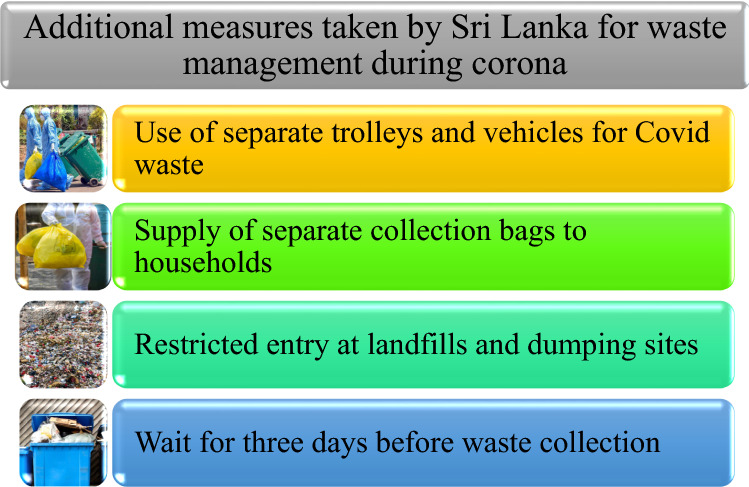
Covid-19 waste management in CHINA: a developing economy
In China during the outbreak of corona pandemic, the waste management sector transformed its waste collection strategy to mandatory segregation of waste at source end (Zanin et al. 2020). All the local bodies were instructed to arrange for separate waste collection quarantine facilities with regular disinfection and sterilization. Disinfection and sterilization played a major role in preventing the secondary infection from waste collection points and other public areas.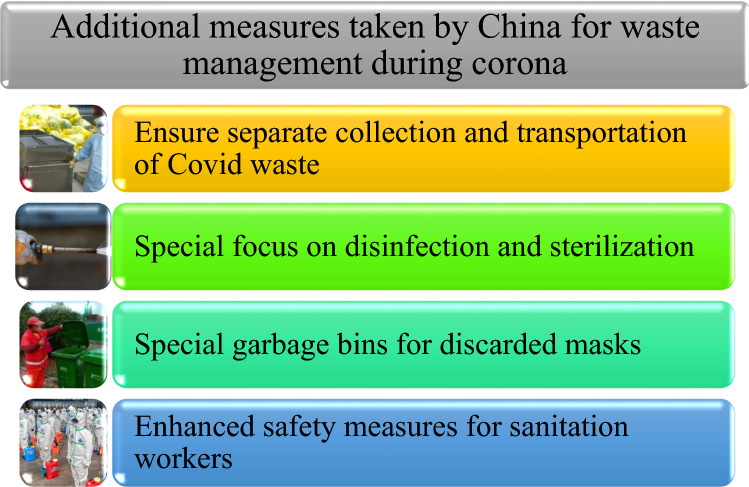
City like Suzhou installed special garbage collection bins for collecting enormous amount of face masks being discarded daily. It ensured intensified drive for sterilization and disinfection of waste collection tolls and public lavatories as well. A city in Bengbu enhanced the precautionary safety measures taken for sanitation workers. They were not only provided with enough protection kits but their medical check-ups were also regularized.
Covid-19 waste management in SOUTH KOREA: a developing economy
The government of South Korea introduced extra measures to fill the gaps between existing waste management systems and unprecedented demands surged due to the pandemic outbreak (Ilyas et al. 2020). It was communicated that corona virus infected waste should be incinerated on the same day of collection and collection time was limited to maximum 24 hours from disposal.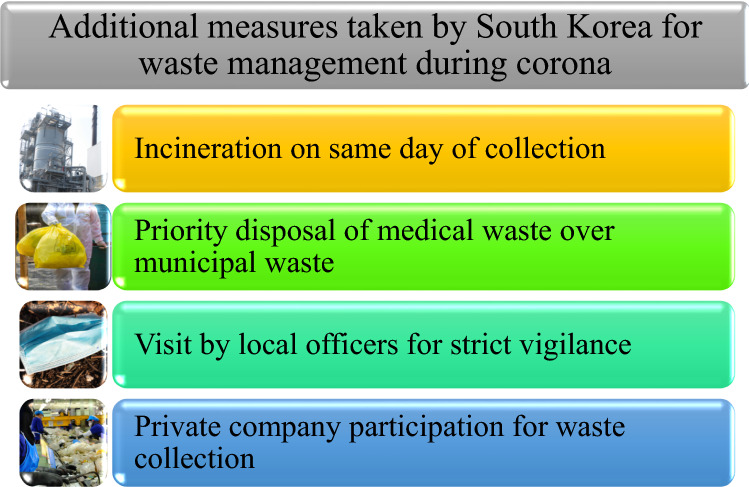
Waste generated from patients quarantined at home facility was to be stored in closed bins and labelled as Covid waste. This waste was disposed of on priority basis as general municipal waste being non-infectious could be stored longer. The emergency response measures taken by government included private company participation for waste collection from healthcare facilities and quarantine sites.
Covid-19 waste management in AUSTRALIA: a developed economy
Australian government rapidly coordinated with the private companies for handling and disposing the Covid infected waste (https://www.health.gov.au/news/managing-coronavirus-clinical-waste). Double bagging of the covid infected waste from the hospitals and quarantine facilities was ensured to reduce the infection rate. To avoid touching of infected waste by the sanitation worker the recommended capacity of garbage bins was ¾ of its total capacity. Additional trucks and frequent collections ensured that bins outside households or medical facilities doesn’t overflows. This saw an unprecedented support from the private companies to fulfil the government’s commitment toward pandemic prevention.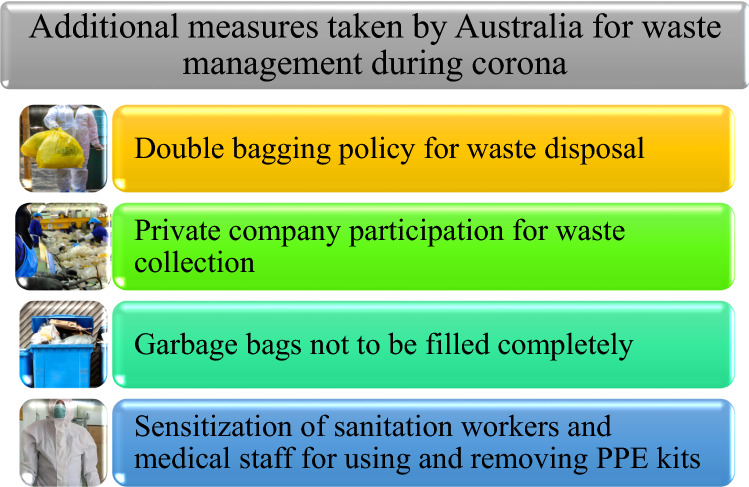
As a general awareness practice, the medical staff and sanitation workers were properly trained and educated for proper use and removal of safety equipment. Even the minute details of how to remove the gloves and googles used while attending a Covid infected patient were communicated. Emphasis was laid on frequent washing and sanitizing the hands before and after exposure to any protection gear.
Covid-19 waste management in USA: a developed economy
The Environmental Protection Agency of USA came forward with additional guidelines to ensure sustainable management strategies for recycling the waste (Nghiem et al. 2020). Few cities there refrained from normal process of recycling the household waste to contaminate the infection spread. An affordable solution of setting up temporary storage areas between the source and treatment facility helped in reducing the burden on waste treatment plants.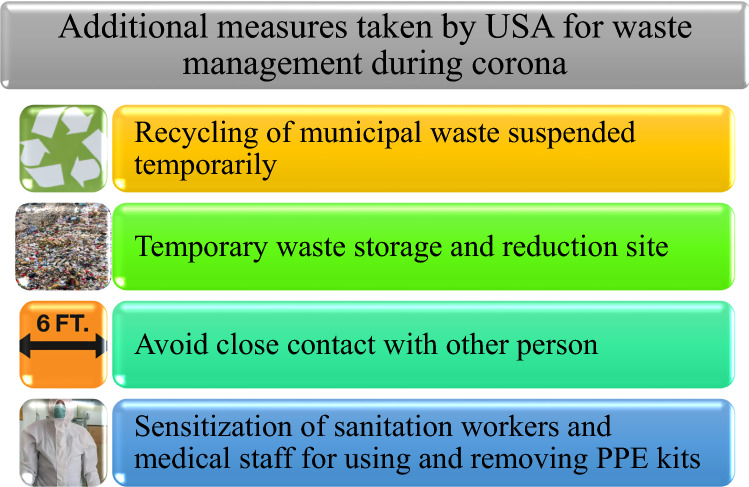
Besides above measures, sanitation workers and other officials were regularly trained for do’s and don’ts of PPE kits. Personal hygiene and regular handwashing played a key role in preventing the spread of virus among community workforce.
Covid-19 waste management in JAPAN: a developed economy
Japan government communicated the officials to consider Covid similar to a disaster situation and formulate waste management strategies accordingly (Onoda 2020). Maximum quantity of infectious waste was sent for incineration, melting or steam sterilization before sending it for shredding process. Remaining waste is either disinfected or sterilized before sending to specific landfills or dumping sites.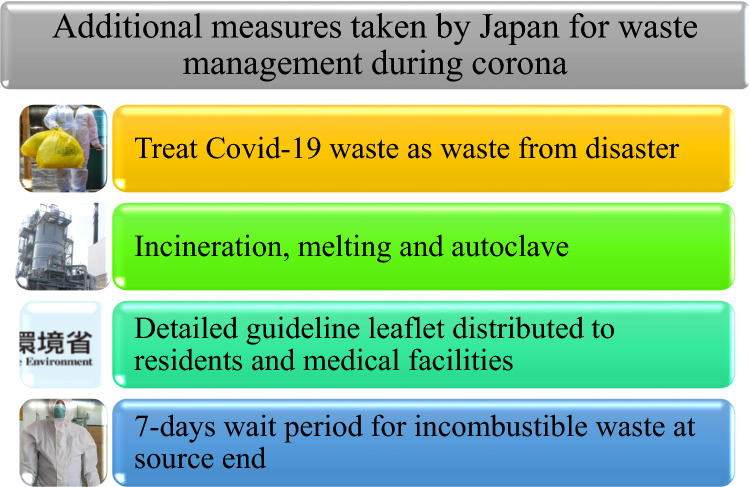
Public sensitization has played a major role in spreading awareness for efficient waste discarding process in Japan. Special efforts were put by government officials to design and distribute small leaflet listing precautions to be taken during corona for self-hygiene and waste disposal. Separate guidelines were formulated and demonstrated for medical staff and general public. In fact, the recyclable material was also mixed with combustible waste and incinerated. For incombustible material a 7 days wait period at source end itself was designated for minimizing the chance of infection spread.
Results and discussion
Analysis of case studies
In this section a brief analysis of various methods of waste management in above listed case studies is presented. As seen from different methodologies, no single policy or framework for solid waste management was suggested by international recommendation bodies like WHO in this pandemic situation. Different nations adopted different techniques based on guidelines issued by WHO and incorporated new methods for additional waste collection and disposal. Certain appreciable steps taken by the countries are listed below which can be considered by countries and corporations in case of such future threats:
Launching of a dedicated app like in case study of India for tracking daily cases is a commendable step for analysis and updating the current strategies being followed. This can help the authorities to monitor the effect of steps taken by government in curbing the menace.
Labelling the plastic bags with labels like ‘COVID WASTE’ can help the sanitary workers to recognize the type of waste for special handling.
Restricting the entry of personnel at those landfills where infectious waste is being treated, like in Sri Lanka, can also prevent the spreading of pathogens.
Priority disposal of medical waste over municipal waste method followed by South Korea is an appreciable step for curbing the infection rate.
Also, temporary participation of private companies for waste disposal can be considered in such situation for speeding up the disposal process. This policy was successfully implemented in South Korea and Australia.
Development of additional temporary waste disposal sites created by USA is a good step to ensure that current landfills are not overburdened and daily waste is collected without delay.
Every nation follows a disaster management plan and guidelines for this situation are already framed and in practice. A lesson from Japan can be learned to treat waste in such situations as disaster waste which will provide early and proper disposal of solid waste without waiting long for detailed guidelines.
However, the below listed practices adopted by above listed countries needs to be considered again for modification as they may increase the risk of spreading the infection:
Waiting time to three days before waste collection, as practiced in Sri Lanka, may increase the risk of infection if such waste is touched by rag-pickers.
Waste disposal bags/plastic bags should be provided by authorities to the households to ensure proper collection of medical waste even from households having people in self-isolation.
Although, steps have been taken by each and every nation for curbing the COVID-19 pandemic infection rate still there are some measures and necessary steps which needs to be included in waste management strategies of every nation. The methods and strategies followed by developed and developing nation in above case studies were found to be more effective and can provide verified solutions in situation like this. In fact, a central framework for pandemic guidelines can be developed based on the models of these nations after further detailed studies. As this work intends to study the model of few economies, detailed verification of model for each country is a vast topic and is not included here.
Conclusion
Loopholes and shortcomings in present waste collection and treatment systems are clearly visible after Covid-19 pandemic situation worldwide. No nation can now afford to further neglect the need of redesigning and revamping the waste management system at individual nation level. A common protocol for effective collection and discard of municipal and medical waste needs to be formulated and monitored by an international body like WHO. Unless nations adopt best policies from already existing strategies and collaborate for further improvements, sustainable solid waste management at global level is impossible to achieve. This work listed already existing policies and guidelines for solid waste management and highlighted their shortcomings in current pandemic like situations. Case studies of above listed developed and developing nations accentuated the extra efforts undertaken by various nations to manage the additional waste generated in their respective countries. A centrally monitored app like CovidBMW launched by India can be considered as good option for live and accurate tracking. Setting up temporary storage sites between source and disposal locations is a praise worthy step taken by USA for immediate relief from rapidly piling waste stocks. Partial filling of garbage bags by Japan helped in reducing the infection rate by preventing sanitation workers from direct touch of infectious waste. Public awareness is a common step followed by almost all the countries under emergency guidelines for Covid pandemic. Learning from our past experiences there is a need to formulate stringent yet flexible strategies for waste disposal at global level.
Declarations
Conflict of interest
We declare that there are no conflicts of interest of any nature.
Ethical approval
All the co-authors have studied and agree with the contents of the manuscript and there is no financial interest to report.
References
- Acharya A, Bastola G, Modi B, et al. The impact of COVID-19 outbreak and perceptions of people towards household waste management chain in Nepal. Geoenviron Disasters. 2021;8:14. doi: 10.1186/s40677-021-00188-w. [DOI] [PMC free article] [PubMed] [Google Scholar]
- Banerjee P, Hazra A, Ghosh P, Ganguly A, Murmu NC, Chatterjee PK. Solid waste management in India: a brief review. In: Ghosh SK, editor. Waste management and resource efficiency. Singapore: Springer; 2019. [Google Scholar]
- Batra A, Sethi GS, Mann S (2019) Personalized automation of electrical and electronic devices using sensors and artificial intelligence—“The Intelligizer System”. Computational intelligence: theories, applications and future directions-Volume I (pp. 523–537). Springer, Singapore
- Behera BC (2021) Challenges in handling COVID-19 contaminated waste material and its sustainable management mechanism. Environmental nanotechnology, monitoring & management, p.100432 [DOI] [PMC free article] [PubMed]
- Chand S, Shastry CS, Hiremath S, Joel JJ, Krishnabhat CH, Mateti UV (2021) Updates on biomedical waste management during COVID-19: the Indian scenario. Clin Epidemiol Global Health, p.100715 [DOI] [PMC free article] [PubMed]
- Chu Z, Wang W, Zhou A, Huang WC. Charging for municipal solid waste disposal in Beijing. Waste Manage. 2019;94:85–94. doi: 10.1016/j.wasman.2019.05.051. [DOI] [PubMed] [Google Scholar]
- Cooper C, Booth A, Varley-Campbell J, Britten N, Garside R. Defining the process to literature searching in systematic reviews: a literature review of guidance and supporting studies. BMC Med Res Methodol. 2018;18(1):1–14. doi: 10.1186/s12874-018-0545-3. [DOI] [PMC free article] [PubMed] [Google Scholar]
- de Oliveira WQ, de Azeredo HMC, Neri-Numa IA, Pastore GM. Food packaging wastes amid the COVID-19 pandemic: trends and challenges. Trends Food Sci Technol. 2021 doi: 10.1016/j.tifs.2021.05.027. [DOI] [PMC free article] [PubMed] [Google Scholar]
- Diggle A, Walker TR. Implementation of harmonized extended producer responsibility strategies to incentivize recovery of single-use plastic packaging waste in Canada. Waste Manage. 2020;110:20–23. doi: 10.1016/j.wasman.2020.05.013. [DOI] [PubMed] [Google Scholar]
- Dunne L, Convery FJ, Gallagher L. An investigation into waste charges in Ireland, with emphasis on public acceptability. Waste Manage. 2008;28(12):2826–2834. doi: 10.1016/j.wasman.2008.07.007. [DOI] [PubMed] [Google Scholar]
- Eisenhardt KM, Graebner ME. Theory building from cases: opportunities and challenges. Acad Manag J. 2007;50(1):25–327. doi: 10.5465/amj.2007.24160888. [DOI] [Google Scholar]
- Hantoko D, Li X, Pariatamby A, Yoshikawa K, Horttanainen M, Yan M. Challenges and practices on waste management and disposal during COVID-19 pandemic. J Environ Manage. 2021;286:112140. doi: 10.1016/j.jenvman.2021.112140. [DOI] [PMC free article] [PubMed] [Google Scholar]
- Haque MS, Uddin S, Sayem SM, Mohib KM. Coronavirus disease 2019 (COVID-19) induced waste scenario: a short overview. J Environ Chem Eng. 2021;9(1):104660. doi: 10.1016/j.jece.2020.104660. [DOI] [PMC free article] [PubMed] [Google Scholar]
- Haque MS, Sharif S, Masnoon A, Rashid E. SARS-CoV-2 pandemic-induced PPE and single-use plastic waste generation scenario. Waste Manag Res. 2021;39:3–17. doi: 10.1177/0734242X20980828. [DOI] [PubMed] [Google Scholar]
- Hartling L, Featherstone R, Nuspl M, Shave K, Dryden DM, Vandermeer B. The contribution of databases to the results of systematic reviews: a cross-sectional study. BMC Med Res Methodol. 2016;16(1):1–13. doi: 10.1186/s12874-016-0232-1. [DOI] [PMC free article] [PubMed] [Google Scholar]
- Hooda S, Mann S. Examining the effectiveness of machine learning algorithms as classifiers for predicting disease severity in data warehouse environments. Revista Argentina De Clín Psicol. 2020;29(4):233. [Google Scholar]
- https://www.eco-business.com/news/adb-coronavirus-could-leave-major-southeast-asian-cities-with-1000-extra-tonnes-of-medical-waste-per-day/
- https://www.health.gov.au/news/managing-coronavirus-clinical-waste
- https://www.worldometers.info/coronavirus/#countries
- Ilyas S, Srivastava RR, Kim H. Disinfection technology and strategies for COVID-19 hospital and bio-medical waste management. Sci Total Environ. 2020;749:141652. doi: 10.1016/j.scitotenv.2020.141652. [DOI] [PMC free article] [PubMed] [Google Scholar]
- Jayasinghe RR, Lythgoe D, Liyanage C, Williams K, Halwatura R (2021) Impact of Covid-related plastic waste–Case of Sri Lanka [DOI] [PMC free article] [PubMed]
- Khanna RC, Cicinelli MV, Gilbert SS, Honavar SG, Murthy G. COVID-19 pandemic: lessons learned and future directions. Indian J Ophthalmol. 2020;68(5):703–710. doi: 10.4103/ijo.IJO_843_20. [DOI] [PMC free article] [PubMed] [Google Scholar]
- Kherwa P, Bansal P. Semantic pattern detection in COVID-19 using contextual clustering and intelligent topic modeling. Int J E-Health Med Commun (IJEHMC) 2021;13(2):1–17. doi: 10.4018/IJEHMC.20220701.oa7. [DOI] [Google Scholar]
- Kulkarni BN, Anantharama V. Repercussions of COVID-19 pandemic on municipal solid waste management: challenges and opportunities. Sci Total Environ. 2020;743:140693. doi: 10.1016/j.scitotenv.2020.140693. [DOI] [PMC free article] [PubMed] [Google Scholar]
- Leal Filho W, Salvia AL, Minhas A, Paço A, Dias-Ferreira C. The COVID-19 pandemic and single-use plastic waste in households: a preliminary study. Sci Total Environ. 2021 doi: 10.1016/j.scitotenv.2021.148571. [DOI] [PMC free article] [PubMed] [Google Scholar]
- Mann S, Arora Y, Anand S (2020) Smart hospitals with the use of 'Internet of Things' and artificial intelligence. In: Proceedings of the International Conference on Innovative Computing & Communications (ICICC).
- Manojkumar P, Suresh M, Ayub Ahmed AA, Panchal H, Rajan CA, Dheepanchakkravarthy A, Geetha A, Gunapriya B, Mann S, Sadasivuni KK (2021) A novel home automation distributed server management system using Internet of Things. Int J Ambient Energy, pp.1–6
- Nghiem LD, Morgan B, Donner E, Short MD. The COVID-19 pandemic: considerations for the waste and wastewater services sector. Case Stud Chem Environ Eng. 2020;1:100006. doi: 10.1016/j.cscee.2020.100006. [DOI] [PMC free article] [PubMed] [Google Scholar]
- Onoda H. Smart approaches to waste management for post-COVID-19 smart cities in Japan. IET Smart Cities. 2020;2(2):89–94. doi: 10.1049/iet-smc.2020.0051. [DOI] [Google Scholar]
- Prata JC, Silva AL, Walker TR, Duarte AC, Rocha-Santos T. COVID-19 pandemic repercussions on the use and management of plastics. Environ Sci Technol. 2020;54(13):7760–7765. doi: 10.1021/acs.est.0c02178. [DOI] [PubMed] [Google Scholar]
- Reschovsky JD, Stone SE. Market incentives to encourage household waste recycling: paying for what you throw away. J Policy Anal Manage. 1994;13(1):120–139. doi: 10.2307/3325093. [DOI] [Google Scholar]
- Rigamonti L, Taelman SE, Huysveld S, Sfez S, Ragaert K, Dewulf J. A step forward in quantifying the substitutability of secondary materials in waste management life cycle assessment studies. Waste Manage. 2020;114:331–340. doi: 10.1016/j.wasman.2020.07.015. [DOI] [PubMed] [Google Scholar]
- Ronca SE, Sturdivant RX, Barr KL, Harris D. SARS-CoV-2 viability on 16 common indoor surface finish materials. HERD Health Environ Res Design J. 2021;14(3):49–64. doi: 10.1177/1937586721991535. [DOI] [PubMed] [Google Scholar]
- Selvaranjan K, Navaratnam S, Rajeev P, Ravintherakumaran N (2021) Environmental challenges induced by extensive use of face masks during COVID-19: a review and potential solutions. Environ Chall. p. 100039 [DOI] [PMC free article] [PubMed]
- Sharma HB, Vanapalli KR, Cheela VS, Ranjan VP, Jaglan AK, Dubey B, Goel S, Bhattacharya J. Challenges, opportunities, and innovations for effective solid waste management during and post COVID-19 pandemic. Resour Conserv Recycl. 2020;162:105052. doi: 10.1016/j.resconrec.2020.105052. [DOI] [PMC free article] [PubMed] [Google Scholar]
- Singh E, Kumar A, Mishra R, Kumar S. Solid waste management during COVID-19 pandemic: recovery techniques and responses. Chemosphere. 2022;288:132451. doi: 10.1016/j.chemosphere.2021.132451. [DOI] [PMC free article] [PubMed] [Google Scholar]
- Tchetchik A, Kaplan S, Blass V. Recycling and consumption reduction following the COVID-19 lockdown: the effect of threat and coping appraisal, past behavior and information. Resour Conserv Recycl. 2021;167:105370. doi: 10.1016/j.resconrec.2020.105370. [DOI] [PMC free article] [PubMed] [Google Scholar]
- Tranfield D, Denyer D, Smart P. Towards a methodology for developing evidence-informed management knowledge by means of systematic review. Br J Manag. 2003;14(3):207–222. doi: 10.1111/1467-8551.00375. [DOI] [Google Scholar]
- UNEP-IETC (2012) Application of the Sustainability Assessment of Technologies Methodology: Guidance Manual. United Nations Environment Programme (UNEP) and International Environmental Technology Centre (IETC)
- Vanapalli KR, Sharma HB, Ranjan VP, Samal B, Bhattacharya J, Dubey BK, Goel S. Challenges and strategies for effective plastic waste management during and post COVID-19 pandemic. Sci Total Environ. 2021;750:141514. doi: 10.1016/j.scitotenv.2020.141514. [DOI] [PMC free article] [PubMed] [Google Scholar]
- WHO. (2015). Safe management of wastes from health-care activities. The World Health Organization. URL: https://apps.who.int/iris/bitstream/handle/10665/85349/9789241548564_eng.pdf;jsessionid=404F93479E9BF429DE9880E2F24A3590?sequence=1
- WHO. (2017). Report on health-care waste management (HCWM) status in Countries of the South-East Asia Region (SEA-EH-593). The World Health Organization. URL: https://apps.who.int/iris/handle/10665/258761
- World Health Organization (2020) Water, sanitation, hygiene, and waste management for the COVID-19 virus: interim guidance, 23 April 2020 (No. WHO/2019-nCoV/IPC_WASH/2020.3). World Health Organization
- Zanin M, Xiao C, Liang T, Ling S, Zhao F, Huang Z, Lin F, Lin X, Jiang Z, Wong SS. The public health response to the COVID-19 outbreak in mainland China: a narrative review. J Thorac Dis. 2020;12(8):4434. doi: 10.21037/jtd-20-2363. [DOI] [PMC free article] [PubMed] [Google Scholar]
- Zimmermann K. Microwave as an emerging technology for the treatment of biohazardous waste: a mini-review. Waste Manage Res. 2017;35(5):471–479. doi: 10.1177/0734242X16684385. [DOI] [PubMed] [Google Scholar]



